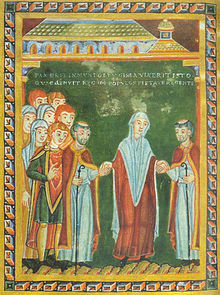Gisela of Swabia
| Gisela of Swabia | |
|---|---|
 Empress Gisela entering a church | |
| Empress of the Holy Roman Empire | |
| Reign | 1027–1039 |
| Coronation | 26 March 1027 St. Peter's Basilica, Rome |
| Coronation | 21 September 1024 Cologne Cathedral |
| Born | c. 990 |
| Died | 15 February 1043 Imperial Palace of Goslar, Saxony |
| Burial | |
| Spouse | Brun I, Count of Brunswick Ernest I, Duke of Swabia Conrad II, Holy Roman Emperor |
| Issue more... | Liudolf, Margrave of Frisia Ernest II, Duke of Swabia Herman IV, Duke of Swabia Henry III, Holy Roman Emperor Matilda of Franconia |
| House | Conradines |
| Father | Herman II, Duke of Swabia |
| Mother | Gerberga of Burgundy |
Gisela of Swabia (c. 990 – 15 February 1043),[1] was queen of Germany from 1024 to 1039 and empress of the Holy Roman Empire from 1027 to 1039 by her third marriage with Emperor Conrad II. She was the mother of Emperor Henry III. She was regent of Swabia for her minor son Duke Ernest II of Swabia in 1015.
Early life[]
Gisela was the daughter of Duke Herman II of Swabia and Gerberga of Burgundy, daughter of King Conrad the Peaceful. Both her parents were descendants of Charlemagne.[2] According to a plate found when her tomb was unearthed, she was born on 11 November 999, but that date cannot be reconciled with the records of her marriages.[1]
Gisela first married the Saxon count Brun I of Brunswick, about 1002.[2] Upon Brun's death, her second marriage was ca. 1012 with the Babenberg scion Ernest,[2] who had been enfeoffed with the Duchy of Swabia by King Henry II of Germany at the death of Gisela's brother, Duke Herman III and aimed at legitimising himself as his heir. After Ernest's early death in 1015, Gisela became regent for their minor son Duke Ernest II of Swabia.
Queen and empress[]
Gisela's third marriage, which took place before January 1017, was to Conrad II, who was elected king of Germany in 1024 and became emperor of the Holy Roman Empire in 1027.[2] According to Thietmar of Merseburg, Archbishop Aribo of Mainz refused to crown her as queen because Gisela and Conrad were too closely related, the couple both descending from King Henry the Fowler.[1] She was instead crowned thirteen days after Conrad's coronation by Archbishop Pilgrim of Cologne.[3] For the same reason, Henry II replaced her as her son's regent with Poppo of Trier, which became the source of conflict between Conrad and Henry.[4]
Gisela played an active part in politics, attending Imperial councils and having her uncle King Rudolph III of Burgundy transfer the succession of his Arelat realm to her husband Conrad. Also, she participated in several synods of the church. She took care of her sister Matilda's daughters Sophie and Beatrice,[5] who later ruled Bar and Tuscany respectively. After Conrad's death in 1039, she and her son Henry III led the mourning progression.[6]

The empress died of dysentery at the Imperial Palace of Goslar in 1043.[1][7] She is interred in the grotto of Speyer Cathedral, Germany along with several emperors and other members of the imperial family. Gisela's tomb was opened in 1900 and her mummified body was found to be 172 cm (5 ft 8 in) tall,[citation needed] with long blond hair.[8]
Children[]
Gisela and Brun I, Count of Brunswick had:[9]
- Liudolf, Margrave of Frisia (c. 1003 – 24 January 1038)
- Daughter (c. 1004 – ?), married Count Thiemo II of Formbach
- Gisela (c. 1005 – c. 1052), married Count Berthold of Sangerhausen
Gisela and Ernest I, Duke of Swabia had:[9]
- Ernest II, Duke of Swabia (c. 1013 – 17 August 1030)
- Herman IV, Duke of Swabia (c. 1015 – 28 July 1038)
Gisela and Conrad II, Holy Roman Emperor had:[10]
- Henry III, Holy Roman Emperor (28 October 1017 – 5 October 1056)[11]
- Matilda (1027 – January 1034), betrothed to Henry I of France
- Beatrix (c. 1030 – 26 September 1036)
Notes[]
- ^ Jump up to: a b c d Appelt, Heinrich (1964), "Gisela", Neue Deutsche Biographie (in German), 6, Berlin: Duncker & Humblot, pp. 413–414; (full text online)
- ^ Jump up to: a b c d Wolfram 2006, p. 32.
- ^ Wolfram 2006, p. 159.
- ^ Bresslau, Harry (1879), "Gisela", Allgemeine Deutsche Biographie (ADB) (in German), 9, Leipzig: Duncker & Humblot, pp. 193–195
- ^ Kagay & Villalon 2003, p. 358.
- ^ Wolfram 2006, p. 346.
- ^ Wolfram 2006, p. 38.
- ^ Wolfram 2006, p. 37.
- ^ Jump up to: a b Wolfram 2006, p. 33.
- ^ Bernhardt, John W. (2002). Itinerant Kingship & Monasteries in Early Medieval Germany, c. 936-1075. Cambridge University Press. p. 311.
- ^ Nash 2017, p. 36.
References[]
| Wikimedia Commons has media related to Gisela of Swabia. |
- Kagay, Donald Joseph; Villalon, L. J. Andrew, eds. (2003). Crusaders, Condottieri, and Cannon: Medieval Warfare in Societies around the Mediterranean. Koninklijke Brill NV.
- Nash, Penelope (2017). Empress Adelheid and Countess Matilda: Medieval Female Rulership and the Foundations of European Society. Palgrave Macmillan.
- Wolfram, Herwig (2006). Conrad II, 990-1039: Emperor of Three Kingdoms. Translated by Kaiser, Denise A. The Pennsylvania State University Press.
- "Women in power 1000-1100" from Guide2womenleaders.com, last accessed January 15, 2007
- Braunschweigisches Biographisches Lexikon, Appelhans 2006, ISBN 3-937664-46-7
- Salian dynasty
- Holy Roman Empresses
- Duchesses of Swabia
- 11th-century women rulers
- Women of medieval Germany
- Burials at Speyer Cathedral
- 990s births
- 1043 deaths
- 11th-century women of the Holy Roman Empire